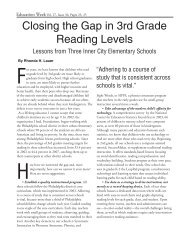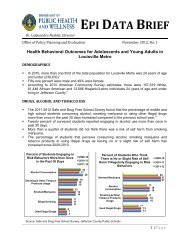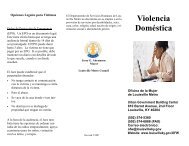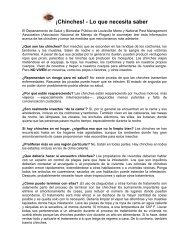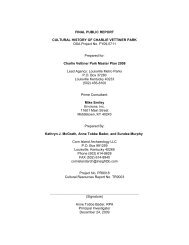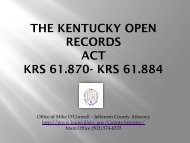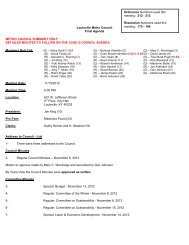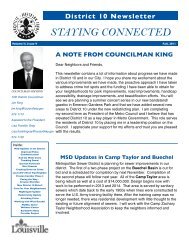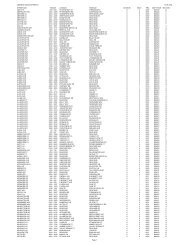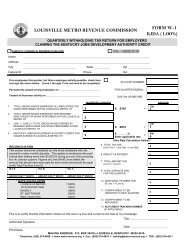Chapter 156 Property Maintenance Code (PDF) - Louisville Metro ...
Chapter 156 Property Maintenance Code (PDF) - Louisville Metro ...
Chapter 156 Property Maintenance Code (PDF) - Louisville Metro ...
You also want an ePaper? Increase the reach of your titles
YUMPU automatically turns print PDFs into web optimized ePapers that Google loves.
(E) Rubbish containers and garbage facilities.<br />
(1) Multifamily properties containing nine or more units. It shall be the duty of every owner of such property<br />
to provide bulk containers of sufficient volume for the frequency of collection and storage of garbage and household<br />
solid waste.<br />
(2) Multifamily properties containing eight or fewer units. It shall be the duty of every owner of such property<br />
to provide a sufficient number of trash containers to meet the demand of each unit of a durable grade of galvanized<br />
metal or plastic from 20 to 40 gallons capacity for the collection and storage of garbage and household solid waste.<br />
The waste container shall be provided with two lifting handles on opposite sides and a tightly fitting cover with a<br />
lifting handle. The tenant shall be responsible for maintaining the trash container(s) supplied by the owner during their<br />
tenancy. The tenant shall also be responsible for placing their trash container(s) at the designated place and time for<br />
trash pick up. Refuse bags, provided by the occupants, made of paper or plastic used for collection must be placed<br />
inside waste containers for collection. Multifamily property owners of eight or fewer units who receive three citations<br />
in a six month period shall be required to provide a bulk container of sufficient volume for the frequency of collection<br />
and storage.<br />
(3) Single-family properties. It shall be the duty of every single family property owner to provide a minimum<br />
of one trash container of a durable grade of galvanized metal or plastic from 20 to 40 gallons capacity for the<br />
collection and storage of garbage and household solid waste. The waste container shall be provided with two lifting<br />
handles on opposite sides and a tightly fitting cover with a lifting handle. Refuse bags made of paper or plastic used<br />
for collection must be placed inside waste containers for collection. Outdoor storage of garbage in plastic or paper<br />
bags is prohibited.<br />
(4) Closed containers required. No household waste shall be placed out of doors awaiting pick-up in any<br />
container except in a closed container or facility with a tight fitting lid; and all wastecontainers and bulk containers<br />
shall be kept in a clean and sanitary condition.<br />
(Jeff. Ord. 37-2002, adopted and effective 11-12-2002; Lou. <strong>Metro</strong> Am. Ord. No. 160-2005, approved 10-18-2005;<br />
Lou. <strong>Metro</strong> Am. Ord. No. 125-2007, approved 7-2-2007)<br />
§ <strong>156</strong>.056 EXTERMINATION.<br />
(A) Infestation. Every reasonable precaution available should be taken to keep all structures from insect and<br />
rodent infestation. All structures in which insects or rodents are found shall be promptly exterminated by approved<br />
processes that will not be injurious to human health. After extermination, proper precautions shall be taken to prevent<br />
re-infestation.<br />
(B) Owner. The owner of any structure shall be responsible for extermination within the structure prior to renting<br />
or leasing the structure.<br />
(C) Single occupant. The occupant of a one-family dwelling or of a single-tenant nonresidential structure shall be<br />
responsible for extermination on the premises.<br />
(D) Multiple occupancy. The owner of a structure containing two or more dwelling units, a multiple occupancy, a<br />
rooming house or a nonresidential structure shall be responsible for extermination in the public or shared areas of the<br />
structure and exterior property. If infestation is caused by failure of an occupant to prevent such infestation in the area<br />
occupied, the occupant shall be responsible for extermination.<br />
(E) Occupant. The occupant of any structure shall be responsible for the continued rodent and pest-free condition<br />
of the structure except where the infestations are caused by defects in the structure, and then, the owner shall be<br />
responsible for extermination.<br />
(Jeff. Ord. 37-2002, adopted and effective 11-12-2002; Lou. <strong>Metro</strong> Am. Ord. No. 125-2007, approved 7-2-2007)<br />
file:///C|/...REGULATIONS%20WEBPAGE%20DOCUMENTS/LMCO%20CHAPTER%20<strong>156</strong>%20PROPERTY%20MAINTENANCE.htm[5/8/2012 11:03:10 AM]



